Comprehensive Assessment Report on Financial Reporting Practices
VerifiedAdded on 2021/06/15
|12
|2598
|24
Report
AI Summary
This report provides a comprehensive assessment of financial reporting, addressing key aspects such as qualitative characteristics, asset revaluation, and relevant theoretical frameworks. Part A examines the qualitative characteristics of financial statements, including understandability, relevance, reliability, and comparability, and critiques the current reporting practices under IFRS. Part B explores the public interest theory, capture theory, and economic interest theory in relation to government regulations. Part C focuses on the controversies surrounding the revaluation of fixed assets under IFRS and GAAP, and the importance of disclosure requirements. Finally, Part D analyzes the reasons behind asset revaluation decisions, the impact of non-revaluation on financial statements, and its potential effects on shareholder wealth. The report incorporates various perspectives and provides a detailed analysis of the subject matter.

2017
Paraphrase This Document
Need a fresh take? Get an instant paraphrase of this document with our AI Paraphraser
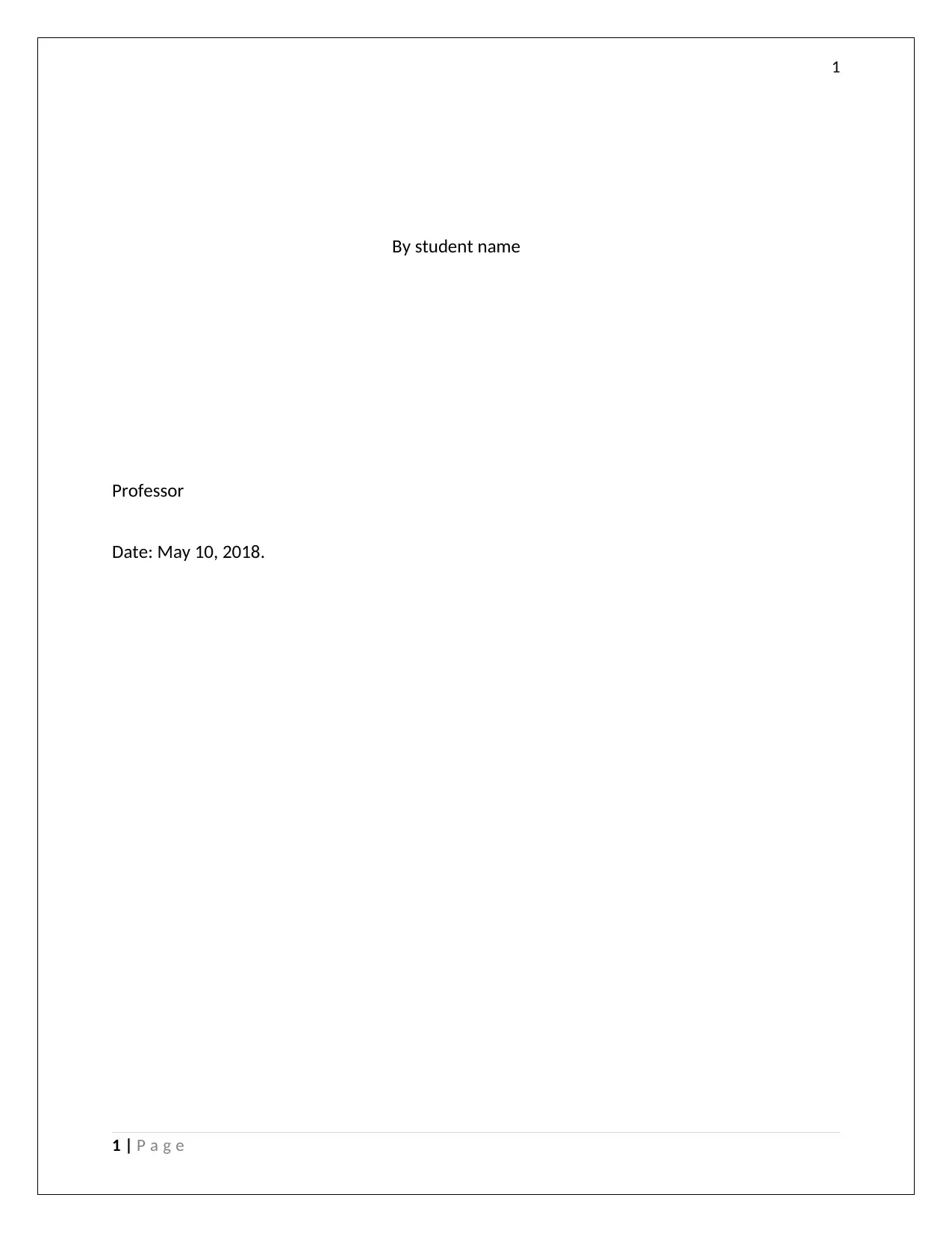
1
By student name
Professor
Date: May 10, 2018.
1 | P a g e
By student name
Professor
Date: May 10, 2018.
1 | P a g e
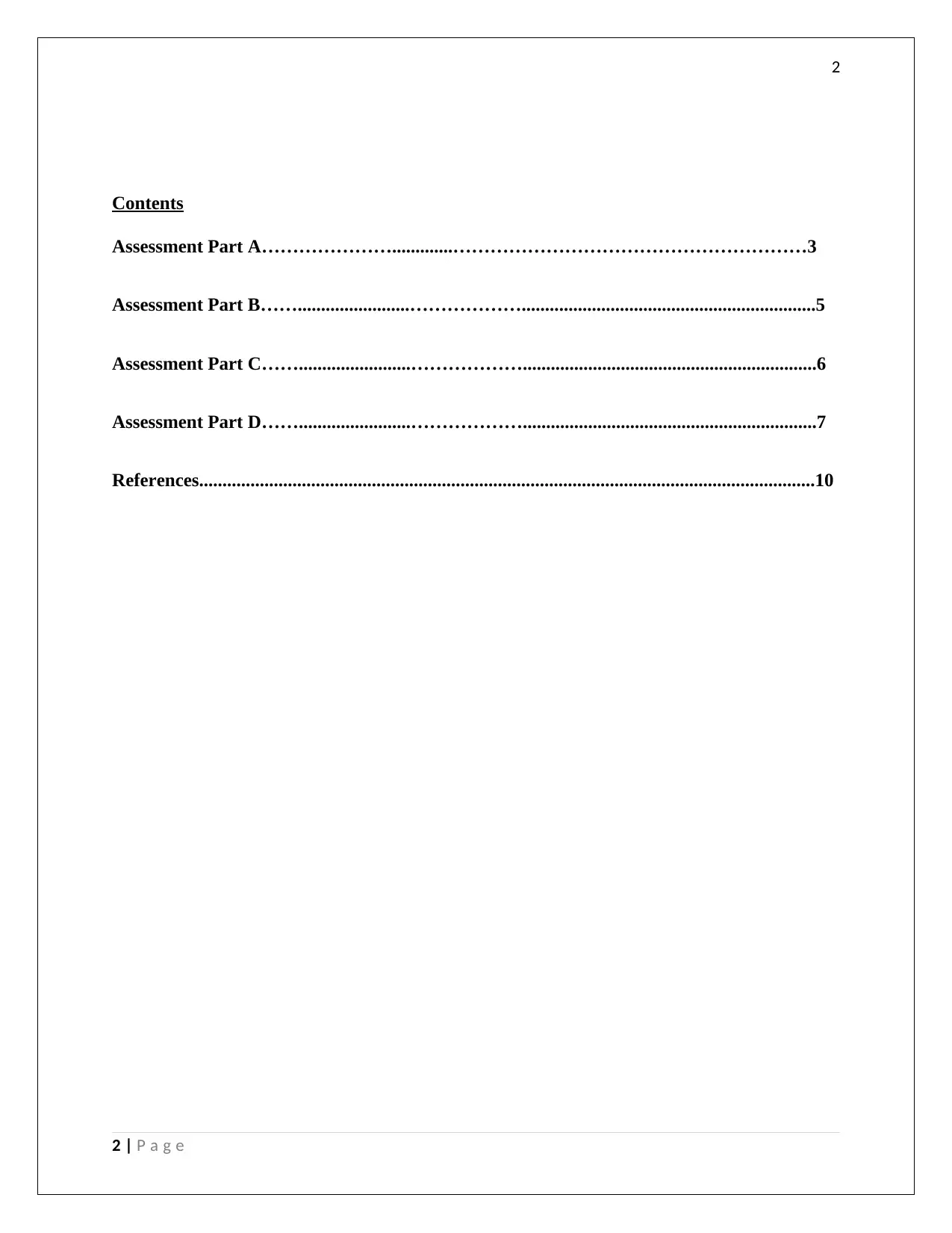
2
Contents
Assessment Part A………………….............…………………………………………………3
Assessment Part B……........................………………...............................................................5
Assessment Part C……........................………………...............................................................6
Assessment Part D……........................………………...............................................................7
References....................................................................................................................................10
2 | P a g e
Contents
Assessment Part A………………….............…………………………………………………3
Assessment Part B……........................………………...............................................................5
Assessment Part C……........................………………...............................................................6
Assessment Part D……........................………………...............................................................7
References....................................................................................................................................10
2 | P a g e
⊘ This is a preview!⊘
Do you want full access?
Subscribe today to unlock all pages.

Trusted by 1+ million students worldwide
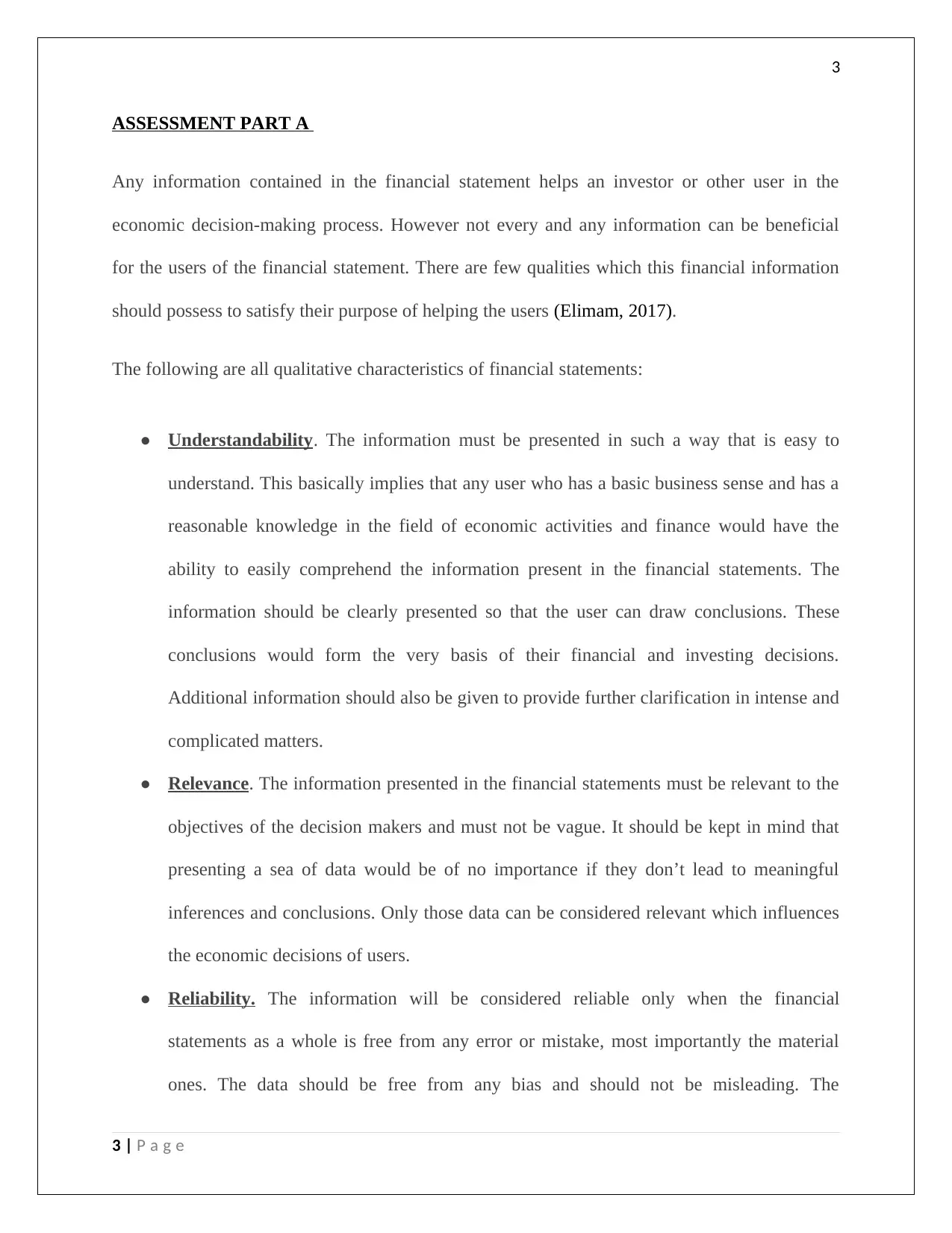
3
ASSESSMENT PART A
Any information contained in the financial statement helps an investor or other user in the
economic decision-making process. However not every and any information can be beneficial
for the users of the financial statement. There are few qualities which this financial information
should possess to satisfy their purpose of helping the users (Elimam, 2017).
The following are all qualitative characteristics of financial statements:
● Understandability. The information must be presented in such a way that is easy to
understand. This basically implies that any user who has a basic business sense and has a
reasonable knowledge in the field of economic activities and finance would have the
ability to easily comprehend the information present in the financial statements. The
information should be clearly presented so that the user can draw conclusions. These
conclusions would form the very basis of their financial and investing decisions.
Additional information should also be given to provide further clarification in intense and
complicated matters.
● Relevance. The information presented in the financial statements must be relevant to the
objectives of the decision makers and must not be vague. It should be kept in mind that
presenting a sea of data would be of no importance if they don’t lead to meaningful
inferences and conclusions. Only those data can be considered relevant which influences
the economic decisions of users.
● Reliability. The information will be considered reliable only when the financial
statements as a whole is free from any error or mistake, most importantly the material
ones. The data should be free from any bias and should not be misleading. The
3 | P a g e
ASSESSMENT PART A
Any information contained in the financial statement helps an investor or other user in the
economic decision-making process. However not every and any information can be beneficial
for the users of the financial statement. There are few qualities which this financial information
should possess to satisfy their purpose of helping the users (Elimam, 2017).
The following are all qualitative characteristics of financial statements:
● Understandability. The information must be presented in such a way that is easy to
understand. This basically implies that any user who has a basic business sense and has a
reasonable knowledge in the field of economic activities and finance would have the
ability to easily comprehend the information present in the financial statements. The
information should be clearly presented so that the user can draw conclusions. These
conclusions would form the very basis of their financial and investing decisions.
Additional information should also be given to provide further clarification in intense and
complicated matters.
● Relevance. The information presented in the financial statements must be relevant to the
objectives of the decision makers and must not be vague. It should be kept in mind that
presenting a sea of data would be of no importance if they don’t lead to meaningful
inferences and conclusions. Only those data can be considered relevant which influences
the economic decisions of users.
● Reliability. The information will be considered reliable only when the financial
statements as a whole is free from any error or mistake, most importantly the material
ones. The data should be free from any bias and should not be misleading. The
3 | P a g e
Paraphrase This Document
Need a fresh take? Get an instant paraphrase of this document with our AI Paraphraser
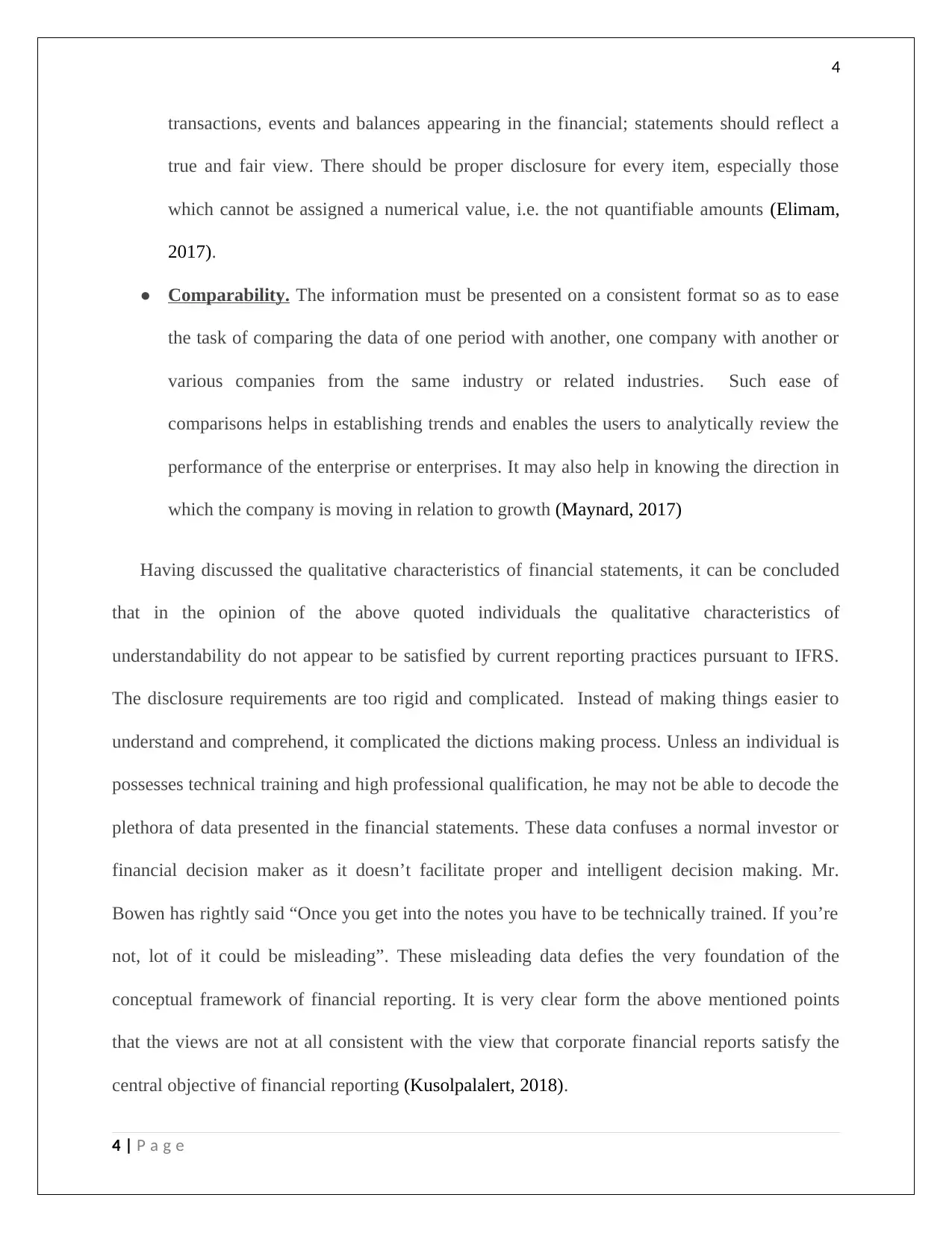
4
transactions, events and balances appearing in the financial; statements should reflect a
true and fair view. There should be proper disclosure for every item, especially those
which cannot be assigned a numerical value, i.e. the not quantifiable amounts (Elimam,
2017).
● Comparability. The information must be presented on a consistent format so as to ease
the task of comparing the data of one period with another, one company with another or
various companies from the same industry or related industries. Such ease of
comparisons helps in establishing trends and enables the users to analytically review the
performance of the enterprise or enterprises. It may also help in knowing the direction in
which the company is moving in relation to growth (Maynard, 2017)
Having discussed the qualitative characteristics of financial statements, it can be concluded
that in the opinion of the above quoted individuals the qualitative characteristics of
understandability do not appear to be satisfied by current reporting practices pursuant to IFRS.
The disclosure requirements are too rigid and complicated. Instead of making things easier to
understand and comprehend, it complicated the dictions making process. Unless an individual is
possesses technical training and high professional qualification, he may not be able to decode the
plethora of data presented in the financial statements. These data confuses a normal investor or
financial decision maker as it doesn’t facilitate proper and intelligent decision making. Mr.
Bowen has rightly said “Once you get into the notes you have to be technically trained. If you’re
not, lot of it could be misleading”. These misleading data defies the very foundation of the
conceptual framework of financial reporting. It is very clear form the above mentioned points
that the views are not at all consistent with the view that corporate financial reports satisfy the
central objective of financial reporting (Kusolpalalert, 2018).
4 | P a g e
transactions, events and balances appearing in the financial; statements should reflect a
true and fair view. There should be proper disclosure for every item, especially those
which cannot be assigned a numerical value, i.e. the not quantifiable amounts (Elimam,
2017).
● Comparability. The information must be presented on a consistent format so as to ease
the task of comparing the data of one period with another, one company with another or
various companies from the same industry or related industries. Such ease of
comparisons helps in establishing trends and enables the users to analytically review the
performance of the enterprise or enterprises. It may also help in knowing the direction in
which the company is moving in relation to growth (Maynard, 2017)
Having discussed the qualitative characteristics of financial statements, it can be concluded
that in the opinion of the above quoted individuals the qualitative characteristics of
understandability do not appear to be satisfied by current reporting practices pursuant to IFRS.
The disclosure requirements are too rigid and complicated. Instead of making things easier to
understand and comprehend, it complicated the dictions making process. Unless an individual is
possesses technical training and high professional qualification, he may not be able to decode the
plethora of data presented in the financial statements. These data confuses a normal investor or
financial decision maker as it doesn’t facilitate proper and intelligent decision making. Mr.
Bowen has rightly said “Once you get into the notes you have to be technically trained. If you’re
not, lot of it could be misleading”. These misleading data defies the very foundation of the
conceptual framework of financial reporting. It is very clear form the above mentioned points
that the views are not at all consistent with the view that corporate financial reports satisfy the
central objective of financial reporting (Kusolpalalert, 2018).
4 | P a g e
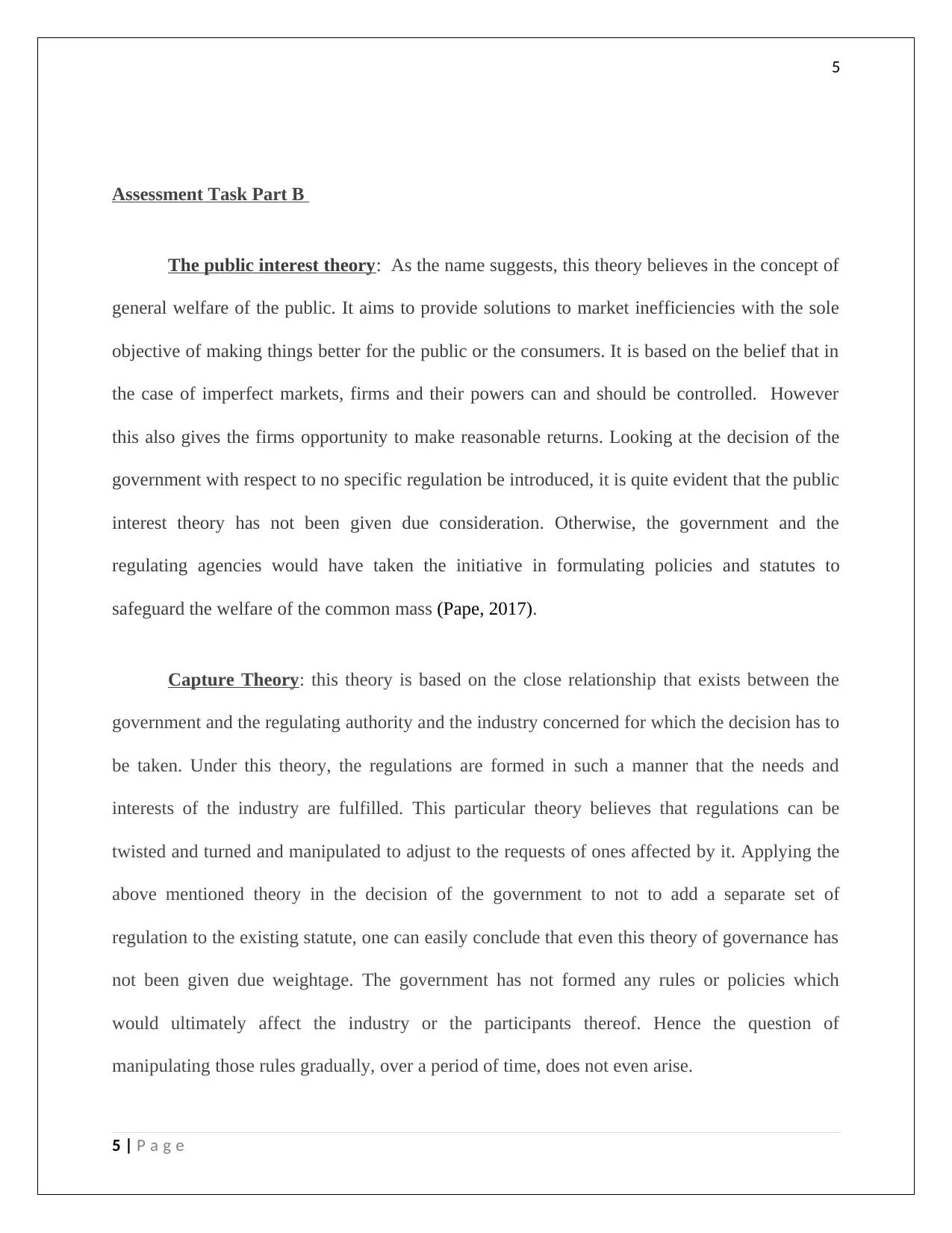
5
Assessment Task Part B
The public interest theory: As the name suggests, this theory believes in the concept of
general welfare of the public. It aims to provide solutions to market inefficiencies with the sole
objective of making things better for the public or the consumers. It is based on the belief that in
the case of imperfect markets, firms and their powers can and should be controlled. However
this also gives the firms opportunity to make reasonable returns. Looking at the decision of the
government with respect to no specific regulation be introduced, it is quite evident that the public
interest theory has not been given due consideration. Otherwise, the government and the
regulating agencies would have taken the initiative in formulating policies and statutes to
safeguard the welfare of the common mass (Pape, 2017).
Capture Theory: this theory is based on the close relationship that exists between the
government and the regulating authority and the industry concerned for which the decision has to
be taken. Under this theory, the regulations are formed in such a manner that the needs and
interests of the industry are fulfilled. This particular theory believes that regulations can be
twisted and turned and manipulated to adjust to the requests of ones affected by it. Applying the
above mentioned theory in the decision of the government to not to add a separate set of
regulation to the existing statute, one can easily conclude that even this theory of governance has
not been given due weightage. The government has not formed any rules or policies which
would ultimately affect the industry or the participants thereof. Hence the question of
manipulating those rules gradually, over a period of time, does not even arise.
5 | P a g e
Assessment Task Part B
The public interest theory: As the name suggests, this theory believes in the concept of
general welfare of the public. It aims to provide solutions to market inefficiencies with the sole
objective of making things better for the public or the consumers. It is based on the belief that in
the case of imperfect markets, firms and their powers can and should be controlled. However
this also gives the firms opportunity to make reasonable returns. Looking at the decision of the
government with respect to no specific regulation be introduced, it is quite evident that the public
interest theory has not been given due consideration. Otherwise, the government and the
regulating agencies would have taken the initiative in formulating policies and statutes to
safeguard the welfare of the common mass (Pape, 2017).
Capture Theory: this theory is based on the close relationship that exists between the
government and the regulating authority and the industry concerned for which the decision has to
be taken. Under this theory, the regulations are formed in such a manner that the needs and
interests of the industry are fulfilled. This particular theory believes that regulations can be
twisted and turned and manipulated to adjust to the requests of ones affected by it. Applying the
above mentioned theory in the decision of the government to not to add a separate set of
regulation to the existing statute, one can easily conclude that even this theory of governance has
not been given due weightage. The government has not formed any rules or policies which
would ultimately affect the industry or the participants thereof. Hence the question of
manipulating those rules gradually, over a period of time, does not even arise.
5 | P a g e
⊘ This is a preview!⊘
Do you want full access?
Subscribe today to unlock all pages.

Trusted by 1+ million students worldwide
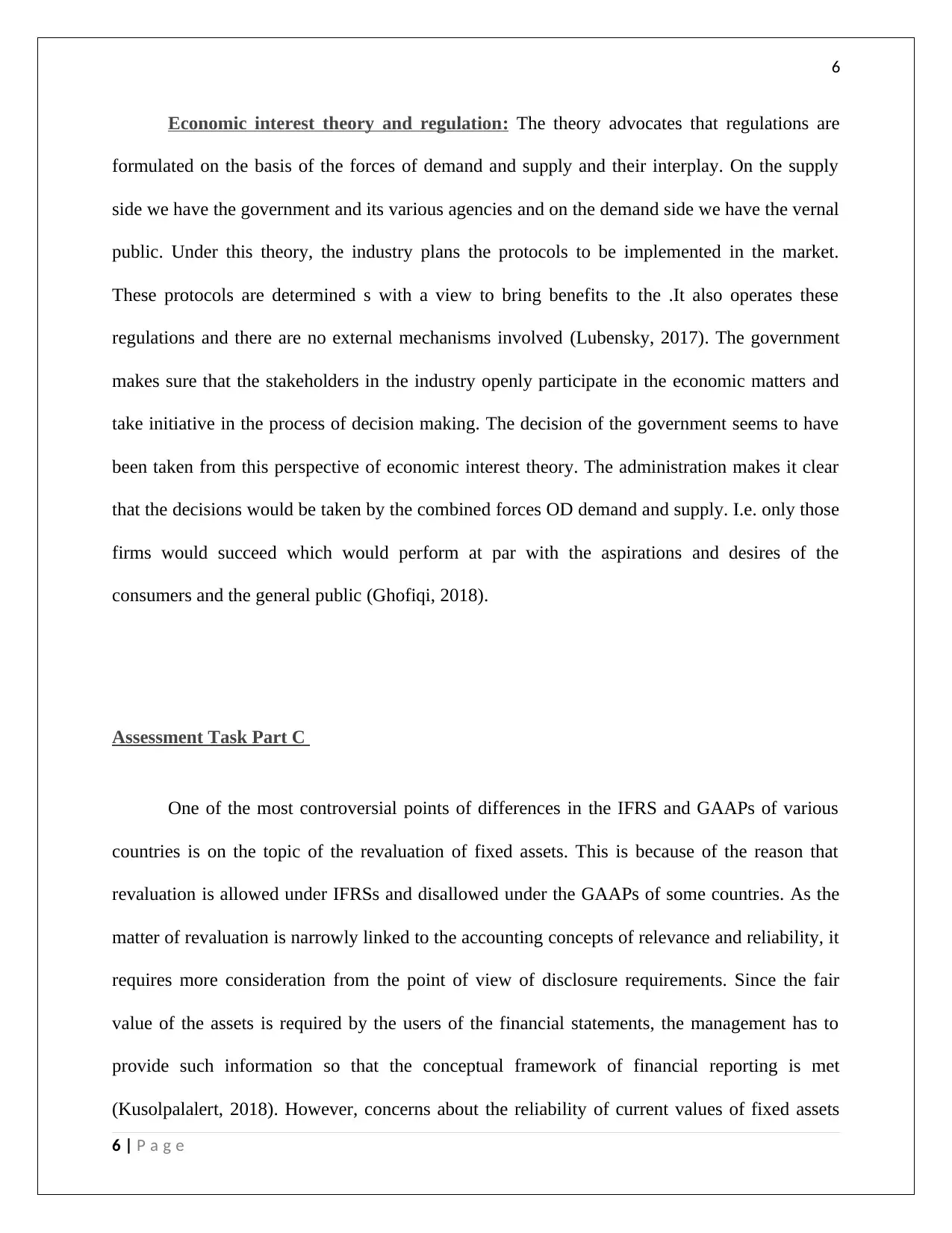
6
Economic interest theory and regulation: The theory advocates that regulations are
formulated on the basis of the forces of demand and supply and their interplay. On the supply
side we have the government and its various agencies and on the demand side we have the vernal
public. Under this theory, the industry plans the protocols to be implemented in the market.
These protocols are determined s with a view to bring benefits to the .It also operates these
regulations and there are no external mechanisms involved (Lubensky, 2017). The government
makes sure that the stakeholders in the industry openly participate in the economic matters and
take initiative in the process of decision making. The decision of the government seems to have
been taken from this perspective of economic interest theory. The administration makes it clear
that the decisions would be taken by the combined forces OD demand and supply. I.e. only those
firms would succeed which would perform at par with the aspirations and desires of the
consumers and the general public (Ghofiqi, 2018).
Assessment Task Part C
One of the most controversial points of differences in the IFRS and GAAPs of various
countries is on the topic of the revaluation of fixed assets. This is because of the reason that
revaluation is allowed under IFRSs and disallowed under the GAAPs of some countries. As the
matter of revaluation is narrowly linked to the accounting concepts of relevance and reliability, it
requires more consideration from the point of view of disclosure requirements. Since the fair
value of the assets is required by the users of the financial statements, the management has to
provide such information so that the conceptual framework of financial reporting is met
(Kusolpalalert, 2018). However, concerns about the reliability of current values of fixed assets
6 | P a g e
Economic interest theory and regulation: The theory advocates that regulations are
formulated on the basis of the forces of demand and supply and their interplay. On the supply
side we have the government and its various agencies and on the demand side we have the vernal
public. Under this theory, the industry plans the protocols to be implemented in the market.
These protocols are determined s with a view to bring benefits to the .It also operates these
regulations and there are no external mechanisms involved (Lubensky, 2017). The government
makes sure that the stakeholders in the industry openly participate in the economic matters and
take initiative in the process of decision making. The decision of the government seems to have
been taken from this perspective of economic interest theory. The administration makes it clear
that the decisions would be taken by the combined forces OD demand and supply. I.e. only those
firms would succeed which would perform at par with the aspirations and desires of the
consumers and the general public (Ghofiqi, 2018).
Assessment Task Part C
One of the most controversial points of differences in the IFRS and GAAPs of various
countries is on the topic of the revaluation of fixed assets. This is because of the reason that
revaluation is allowed under IFRSs and disallowed under the GAAPs of some countries. As the
matter of revaluation is narrowly linked to the accounting concepts of relevance and reliability, it
requires more consideration from the point of view of disclosure requirements. Since the fair
value of the assets is required by the users of the financial statements, the management has to
provide such information so that the conceptual framework of financial reporting is met
(Kusolpalalert, 2018). However, concerns about the reliability of current values of fixed assets
6 | P a g e
Paraphrase This Document
Need a fresh take? Get an instant paraphrase of this document with our AI Paraphraser
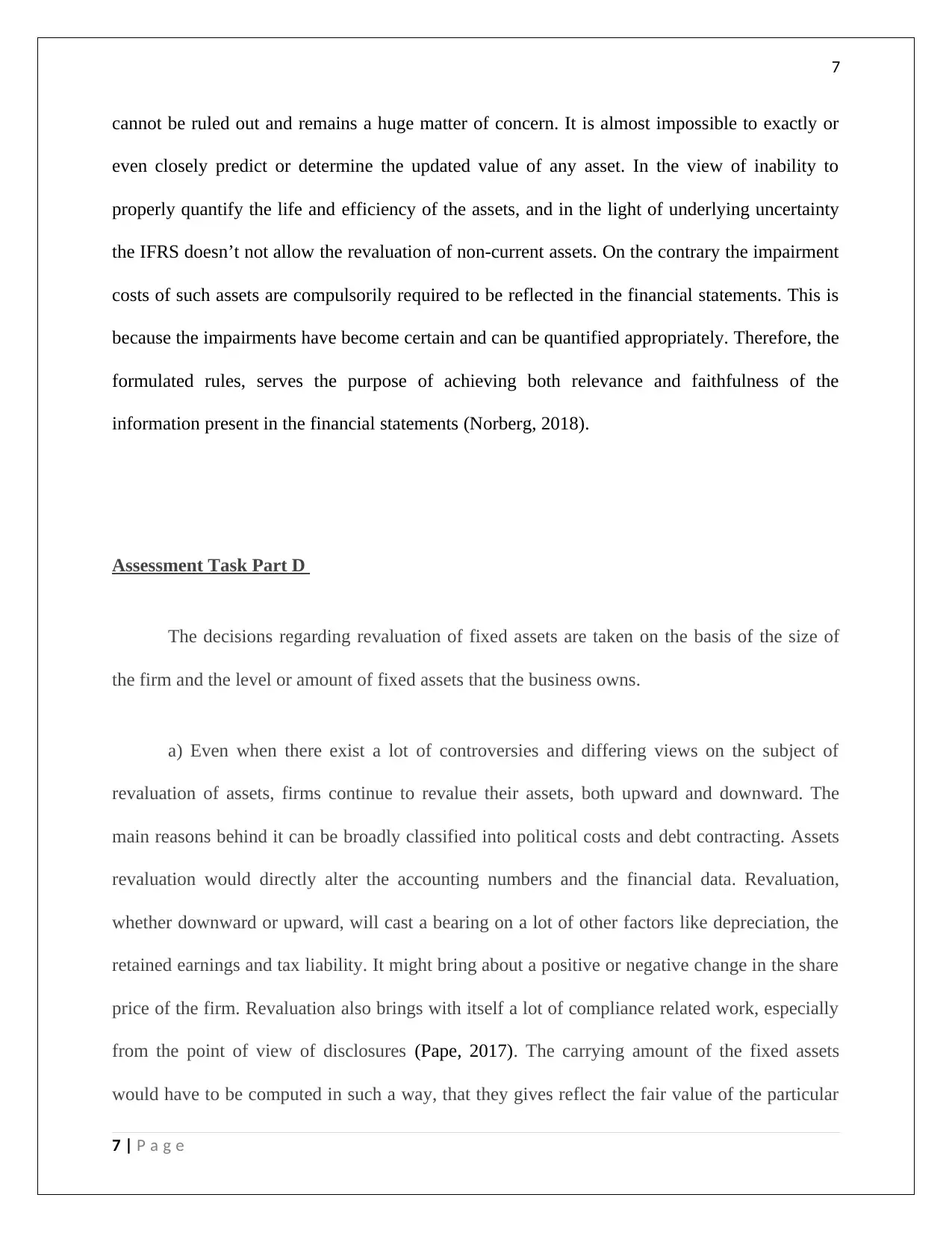
7
cannot be ruled out and remains a huge matter of concern. It is almost impossible to exactly or
even closely predict or determine the updated value of any asset. In the view of inability to
properly quantify the life and efficiency of the assets, and in the light of underlying uncertainty
the IFRS doesn’t not allow the revaluation of non-current assets. On the contrary the impairment
costs of such assets are compulsorily required to be reflected in the financial statements. This is
because the impairments have become certain and can be quantified appropriately. Therefore, the
formulated rules, serves the purpose of achieving both relevance and faithfulness of the
information present in the financial statements (Norberg, 2018).
Assessment Task Part D
The decisions regarding revaluation of fixed assets are taken on the basis of the size of
the firm and the level or amount of fixed assets that the business owns.
a) Even when there exist a lot of controversies and differing views on the subject of
revaluation of assets, firms continue to revalue their assets, both upward and downward. The
main reasons behind it can be broadly classified into political costs and debt contracting. Assets
revaluation would directly alter the accounting numbers and the financial data. Revaluation,
whether downward or upward, will cast a bearing on a lot of other factors like depreciation, the
retained earnings and tax liability. It might bring about a positive or negative change in the share
price of the firm. Revaluation also brings with itself a lot of compliance related work, especially
from the point of view of disclosures (Pape, 2017). The carrying amount of the fixed assets
would have to be computed in such a way, that they gives reflect the fair value of the particular
7 | P a g e
cannot be ruled out and remains a huge matter of concern. It is almost impossible to exactly or
even closely predict or determine the updated value of any asset. In the view of inability to
properly quantify the life and efficiency of the assets, and in the light of underlying uncertainty
the IFRS doesn’t not allow the revaluation of non-current assets. On the contrary the impairment
costs of such assets are compulsorily required to be reflected in the financial statements. This is
because the impairments have become certain and can be quantified appropriately. Therefore, the
formulated rules, serves the purpose of achieving both relevance and faithfulness of the
information present in the financial statements (Norberg, 2018).
Assessment Task Part D
The decisions regarding revaluation of fixed assets are taken on the basis of the size of
the firm and the level or amount of fixed assets that the business owns.
a) Even when there exist a lot of controversies and differing views on the subject of
revaluation of assets, firms continue to revalue their assets, both upward and downward. The
main reasons behind it can be broadly classified into political costs and debt contracting. Assets
revaluation would directly alter the accounting numbers and the financial data. Revaluation,
whether downward or upward, will cast a bearing on a lot of other factors like depreciation, the
retained earnings and tax liability. It might bring about a positive or negative change in the share
price of the firm. Revaluation also brings with itself a lot of compliance related work, especially
from the point of view of disclosures (Pape, 2017). The carrying amount of the fixed assets
would have to be computed in such a way, that they gives reflect the fair value of the particular
7 | P a g e
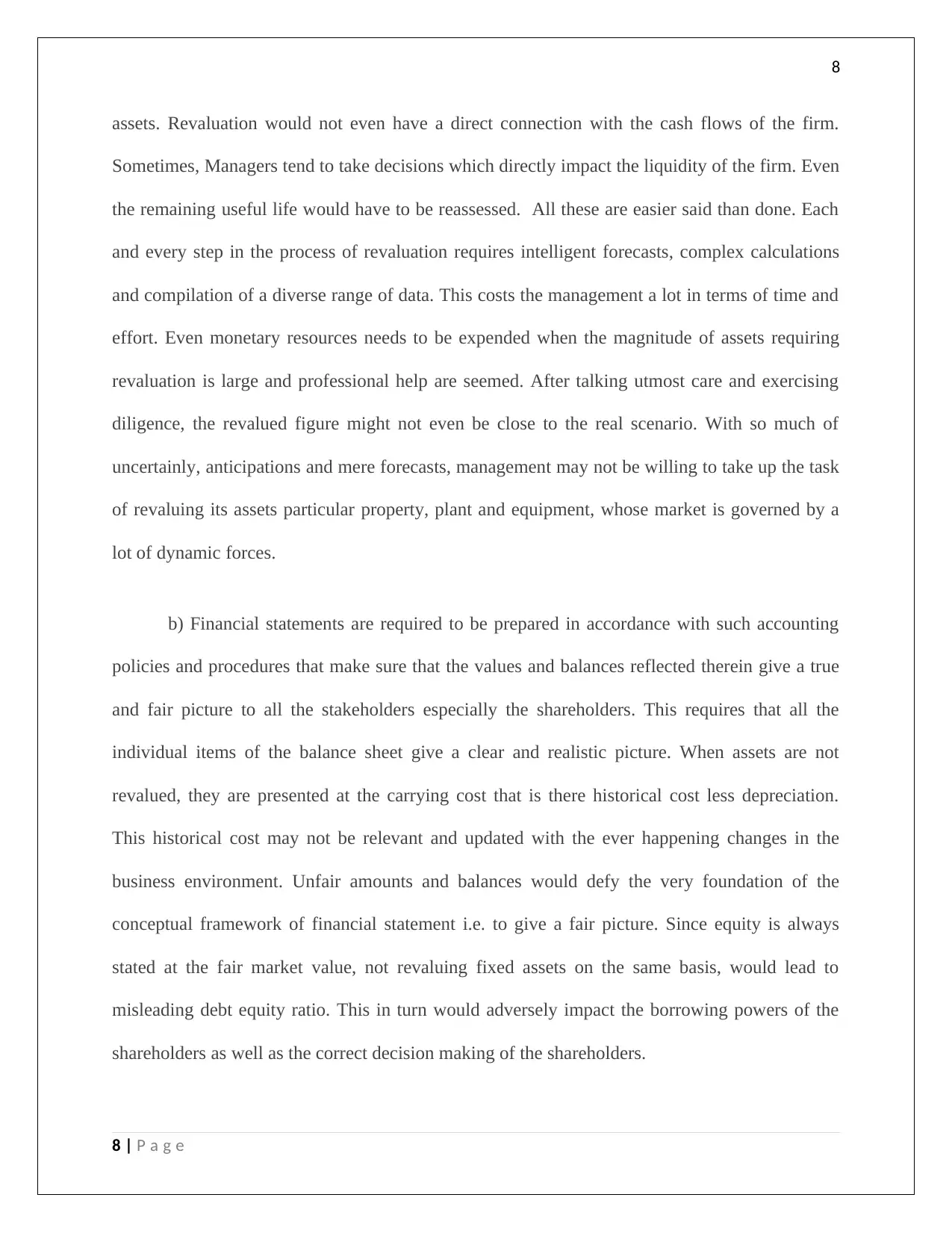
8
assets. Revaluation would not even have a direct connection with the cash flows of the firm.
Sometimes, Managers tend to take decisions which directly impact the liquidity of the firm. Even
the remaining useful life would have to be reassessed. All these are easier said than done. Each
and every step in the process of revaluation requires intelligent forecasts, complex calculations
and compilation of a diverse range of data. This costs the management a lot in terms of time and
effort. Even monetary resources needs to be expended when the magnitude of assets requiring
revaluation is large and professional help are seemed. After talking utmost care and exercising
diligence, the revalued figure might not even be close to the real scenario. With so much of
uncertainly, anticipations and mere forecasts, management may not be willing to take up the task
of revaluing its assets particular property, plant and equipment, whose market is governed by a
lot of dynamic forces.
b) Financial statements are required to be prepared in accordance with such accounting
policies and procedures that make sure that the values and balances reflected therein give a true
and fair picture to all the stakeholders especially the shareholders. This requires that all the
individual items of the balance sheet give a clear and realistic picture. When assets are not
revalued, they are presented at the carrying cost that is there historical cost less depreciation.
This historical cost may not be relevant and updated with the ever happening changes in the
business environment. Unfair amounts and balances would defy the very foundation of the
conceptual framework of financial statement i.e. to give a fair picture. Since equity is always
stated at the fair market value, not revaluing fixed assets on the same basis, would lead to
misleading debt equity ratio. This in turn would adversely impact the borrowing powers of the
shareholders as well as the correct decision making of the shareholders.
8 | P a g e
assets. Revaluation would not even have a direct connection with the cash flows of the firm.
Sometimes, Managers tend to take decisions which directly impact the liquidity of the firm. Even
the remaining useful life would have to be reassessed. All these are easier said than done. Each
and every step in the process of revaluation requires intelligent forecasts, complex calculations
and compilation of a diverse range of data. This costs the management a lot in terms of time and
effort. Even monetary resources needs to be expended when the magnitude of assets requiring
revaluation is large and professional help are seemed. After talking utmost care and exercising
diligence, the revalued figure might not even be close to the real scenario. With so much of
uncertainly, anticipations and mere forecasts, management may not be willing to take up the task
of revaluing its assets particular property, plant and equipment, whose market is governed by a
lot of dynamic forces.
b) Financial statements are required to be prepared in accordance with such accounting
policies and procedures that make sure that the values and balances reflected therein give a true
and fair picture to all the stakeholders especially the shareholders. This requires that all the
individual items of the balance sheet give a clear and realistic picture. When assets are not
revalued, they are presented at the carrying cost that is there historical cost less depreciation.
This historical cost may not be relevant and updated with the ever happening changes in the
business environment. Unfair amounts and balances would defy the very foundation of the
conceptual framework of financial statement i.e. to give a fair picture. Since equity is always
stated at the fair market value, not revaluing fixed assets on the same basis, would lead to
misleading debt equity ratio. This in turn would adversely impact the borrowing powers of the
shareholders as well as the correct decision making of the shareholders.
8 | P a g e
⊘ This is a preview!⊘
Do you want full access?
Subscribe today to unlock all pages.

Trusted by 1+ million students worldwide
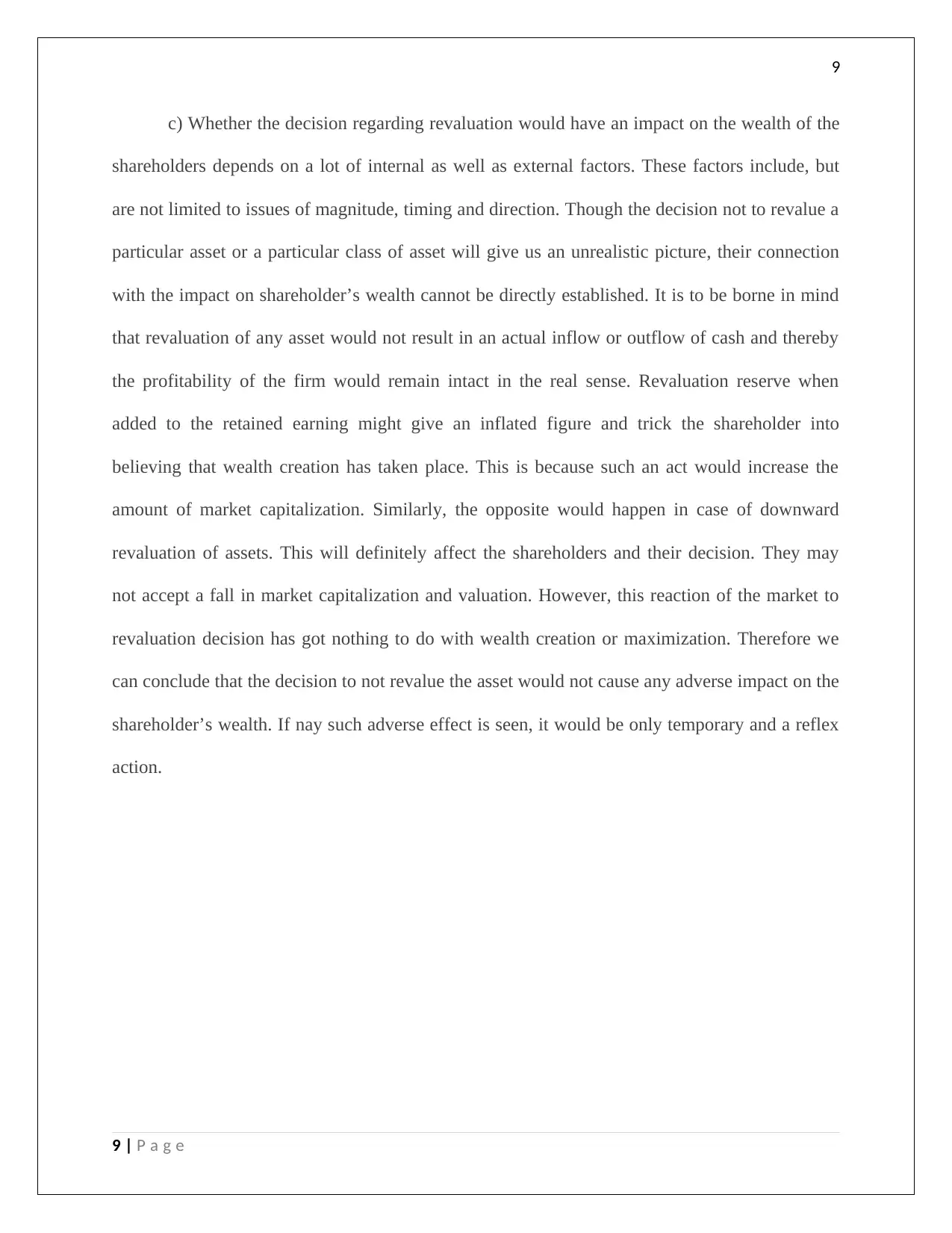
9
c) Whether the decision regarding revaluation would have an impact on the wealth of the
shareholders depends on a lot of internal as well as external factors. These factors include, but
are not limited to issues of magnitude, timing and direction. Though the decision not to revalue a
particular asset or a particular class of asset will give us an unrealistic picture, their connection
with the impact on shareholder’s wealth cannot be directly established. It is to be borne in mind
that revaluation of any asset would not result in an actual inflow or outflow of cash and thereby
the profitability of the firm would remain intact in the real sense. Revaluation reserve when
added to the retained earning might give an inflated figure and trick the shareholder into
believing that wealth creation has taken place. This is because such an act would increase the
amount of market capitalization. Similarly, the opposite would happen in case of downward
revaluation of assets. This will definitely affect the shareholders and their decision. They may
not accept a fall in market capitalization and valuation. However, this reaction of the market to
revaluation decision has got nothing to do with wealth creation or maximization. Therefore we
can conclude that the decision to not revalue the asset would not cause any adverse impact on the
shareholder’s wealth. If nay such adverse effect is seen, it would be only temporary and a reflex
action.
9 | P a g e
c) Whether the decision regarding revaluation would have an impact on the wealth of the
shareholders depends on a lot of internal as well as external factors. These factors include, but
are not limited to issues of magnitude, timing and direction. Though the decision not to revalue a
particular asset or a particular class of asset will give us an unrealistic picture, their connection
with the impact on shareholder’s wealth cannot be directly established. It is to be borne in mind
that revaluation of any asset would not result in an actual inflow or outflow of cash and thereby
the profitability of the firm would remain intact in the real sense. Revaluation reserve when
added to the retained earning might give an inflated figure and trick the shareholder into
believing that wealth creation has taken place. This is because such an act would increase the
amount of market capitalization. Similarly, the opposite would happen in case of downward
revaluation of assets. This will definitely affect the shareholders and their decision. They may
not accept a fall in market capitalization and valuation. However, this reaction of the market to
revaluation decision has got nothing to do with wealth creation or maximization. Therefore we
can conclude that the decision to not revalue the asset would not cause any adverse impact on the
shareholder’s wealth. If nay such adverse effect is seen, it would be only temporary and a reflex
action.
9 | P a g e
Paraphrase This Document
Need a fresh take? Get an instant paraphrase of this document with our AI Paraphraser
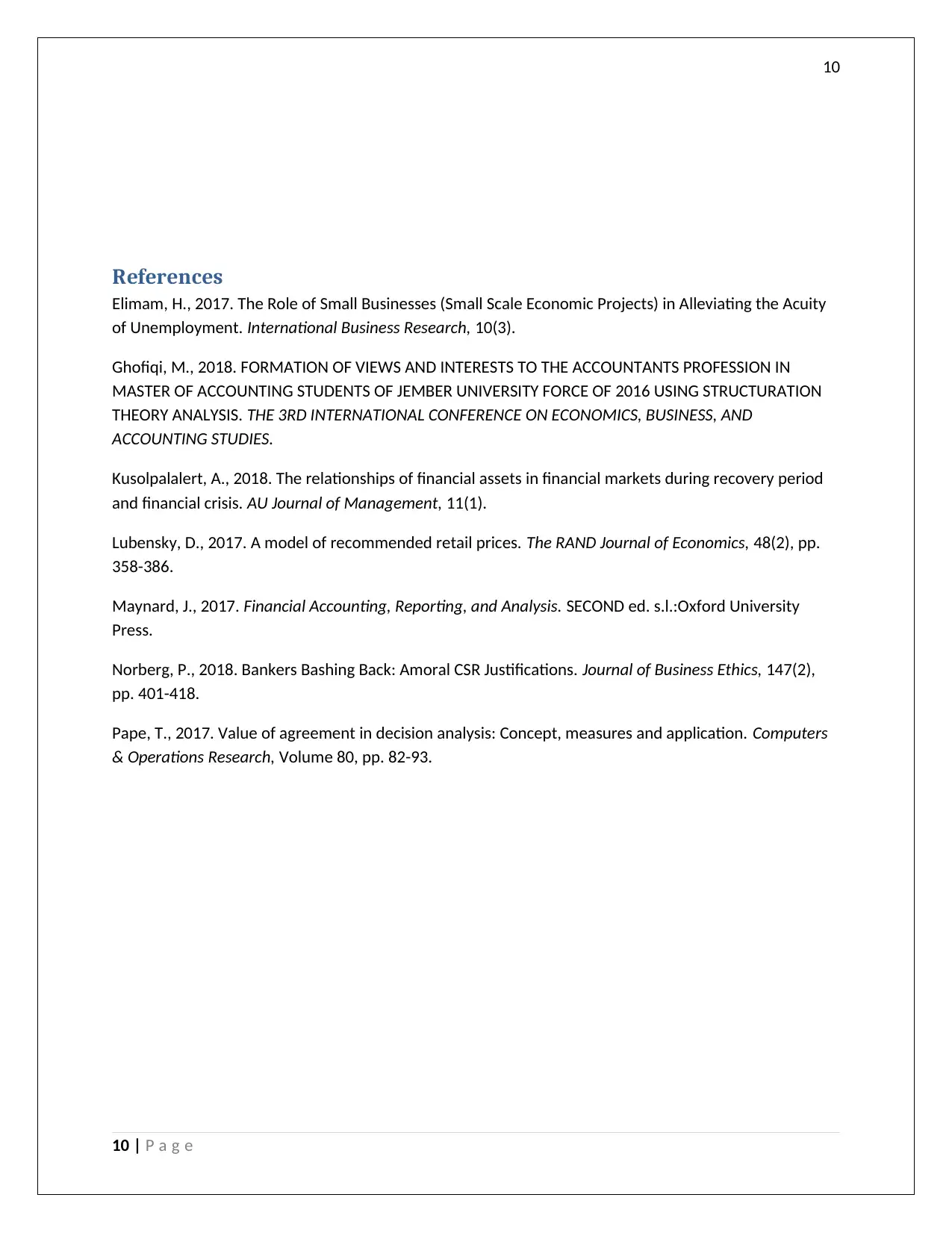
10
References
Elimam, H., 2017. The Role of Small Businesses (Small Scale Economic Projects) in Alleviating the Acuity
of Unemployment. International Business Research, 10(3).
Ghofiqi, M., 2018. FORMATION OF VIEWS AND INTERESTS TO THE ACCOUNTANTS PROFESSION IN
MASTER OF ACCOUNTING STUDENTS OF JEMBER UNIVERSITY FORCE OF 2016 USING STRUCTURATION
THEORY ANALYSIS. THE 3RD INTERNATIONAL CONFERENCE ON ECONOMICS, BUSINESS, AND
ACCOUNTING STUDIES.
Kusolpalalert, A., 2018. The relationships of financial assets in financial markets during recovery period
and financial crisis. AU Journal of Management, 11(1).
Lubensky, D., 2017. A model of recommended retail prices. The RAND Journal of Economics, 48(2), pp.
358-386.
Maynard, J., 2017. Financial Accounting, Reporting, and Analysis. SECOND ed. s.l.:Oxford University
Press.
Norberg, P., 2018. Bankers Bashing Back: Amoral CSR Justifications. Journal of Business Ethics, 147(2),
pp. 401-418.
Pape, T., 2017. Value of agreement in decision analysis: Concept, measures and application. Computers
& Operations Research, Volume 80, pp. 82-93.
10 | P a g e
References
Elimam, H., 2017. The Role of Small Businesses (Small Scale Economic Projects) in Alleviating the Acuity
of Unemployment. International Business Research, 10(3).
Ghofiqi, M., 2018. FORMATION OF VIEWS AND INTERESTS TO THE ACCOUNTANTS PROFESSION IN
MASTER OF ACCOUNTING STUDENTS OF JEMBER UNIVERSITY FORCE OF 2016 USING STRUCTURATION
THEORY ANALYSIS. THE 3RD INTERNATIONAL CONFERENCE ON ECONOMICS, BUSINESS, AND
ACCOUNTING STUDIES.
Kusolpalalert, A., 2018. The relationships of financial assets in financial markets during recovery period
and financial crisis. AU Journal of Management, 11(1).
Lubensky, D., 2017. A model of recommended retail prices. The RAND Journal of Economics, 48(2), pp.
358-386.
Maynard, J., 2017. Financial Accounting, Reporting, and Analysis. SECOND ed. s.l.:Oxford University
Press.
Norberg, P., 2018. Bankers Bashing Back: Amoral CSR Justifications. Journal of Business Ethics, 147(2),
pp. 401-418.
Pape, T., 2017. Value of agreement in decision analysis: Concept, measures and application. Computers
& Operations Research, Volume 80, pp. 82-93.
10 | P a g e

11
11 | P a g e
11 | P a g e
⊘ This is a preview!⊘
Do you want full access?
Subscribe today to unlock all pages.

Trusted by 1+ million students worldwide
1 out of 12
Related Documents
Your All-in-One AI-Powered Toolkit for Academic Success.
+13062052269
info@desklib.com
Available 24*7 on WhatsApp / Email
![[object Object]](/_next/static/media/star-bottom.7253800d.svg)
Unlock your academic potential
Copyright © 2020–2025 A2Z Services. All Rights Reserved. Developed and managed by ZUCOL.





